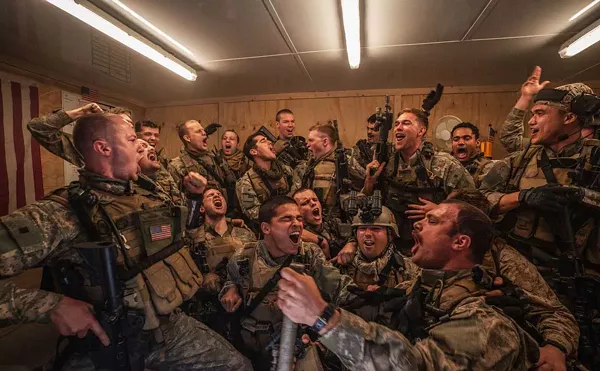
Audio By Carbonatix
[
{
"name": "GPT - Leaderboard - Inline - Content",
"component": "35519556",
"insertPoint": "5th",
"startingPoint": "3",
"requiredCountToDisplay": "3",
"maxInsertions": 100,
"adList": [
{
"adPreset": "LeaderboardInline"
}
]
}
]
Put simply, The League of Extraordinary Gentlemen, Volume 1 pushes the boundaries of the team-up formula into new territory. Eighteen years after his groundbreaking Watchmen first appeared, Alan Moore is looking toward the future of comics by, oddly enough, looking back.
In LXG (to borrow the theatrical acronym), Moore collaborates with some of the best authors in English literature — H.G. Wells, Jules Verne, H. Rider Haggard, Bram Stoker and Robert Louis Stevenson — i.e. a range of very different prose styles, coupled with the distinct narrative aims of each writer and the pulse of London somewhere behind it all. It would seem that, aside from their placement in the 19th century, these characters have little to do with one another. But this is Alan Moore we’re talking about. The famed graphic novelist, the very genius who turned comics on their heads, is still writing brilliantly.
LXG is an intelligent work that may be read as a team-up alternative or as a long, satisfying, literary treasure hunt. There’s Campion Bond, the head of the secret service in London and the liaison to the League’s employer, the mysterious Mr. M. We have the beautiful Mina Murray (recently estranged from her husband and with a dark and unmentionable past) who heads the team; Allan Quartermain, adventurer and recovering opium addict; Dr. Jekyll, who no longer needs the potion to turn into the raging Mr. Edward Hyde (as with the Hulk, you wouldn’t like him when he’s angry); Nemo, the mysterious captain of the Nautilus; and Hawley Griffin, “The Invisible Man,” sex addict and all-round sneaky guy, working for his pardon and a possible cure.
The League must stop Moriarty (the nemesis of Sherlock Holmes) from causing the destruction of London with the cavorite, an antigravity unit used by Moriarty to create the first flying death ship, or “war chariot” as it’s referred to in the book.
LXG is about taking the unlikeliest of monsters and turning them into heroes. I’d have to cast my vote for Mr. Griffin as my favorite monster (um, character). He happens to be filthy, unpredictable, dark, sinister and weirdly humorous. (I like my characters filthy, unpredictable, dark, sinister and weirdly humorous.) And there’s plenty of sexual tension between Miss Murray and Quartermain to satisfy the reader — slightly reminiscent of Leia and Han Solo in Star Wars, but a Victorian version, much naughtier by comparison.
The book succeeds thanks to Moore’s skillful characterizations and near-perfect dialogue, guided visually by the breathtaking art of Kevin O’Neill. The result is a masterpiece of not only graphic literature, but — yes, I’ll dare say it — contemporary literature. No “isms” or other compound words need apply. The book closes with the novelette “Allan and the Sundered Veil” and a gallery of the original cover art from the series.
With the release of the movie on July 11 and incessant complaints by fans of comic books and critics of the movies that are made from them (I’m probably the only person in the world who actually liked Hulk), I offer a few reasons why you should read this collection:
1) You won’t have to wait six months for the DVD release and you needn’t buy the exact same DVD three to four months later under the auspices of “now with more than seven hours of new footage and director commentaries.”
2) It’s roughly the price of a DVD ($14.95), only it looks cooler on your shelf next to The Brothers Karamazov and Lolita: unabridged.
3) “The comic book’s always better than the movie.” Well, as a rule that’s true, because comics (and most graphic literature) are often treated as just another screenplay by most film producers and big-budget directors — and why do comics have to be made into films anyway?
I like my comics as comics, my films as films and my books as books, not some desperate hybrid tied to a financial machine whose only purpose is to get as many seats filled before word spreads that the film is a disaster.
Moore has found a solution: He consciously attempts to write comics that are difficult to translate into film. And God bless him for it. Hollywood has shown, through its cannibalization of the medium, that comics are cool and profitable, but they forget about the art part, which usually gets lost somewhere between projected sales and opening weekend extrapolations.
In spite of LXG's cleverness — the book being, in my opinion, the best candidate for a comics-to-film transplant — Hollywood seems to have muffed up yet another good idea. I anticipated some backlash here and there, but the shouts from disgruntled viewers and critics alike have shifted my position considerably. I don't want to see the movie. Why should I? LXG is right there on the page for me to see. And sitting through a bad adaptation of a great comic book would just add insult to injury.
My advice: Read LXG: Volume 1 and wait patiently for the sequel. I will.
Cornelius A. Fortune is a Detroit-based writer of fiction. E-mail letters@metrotimes.com.





